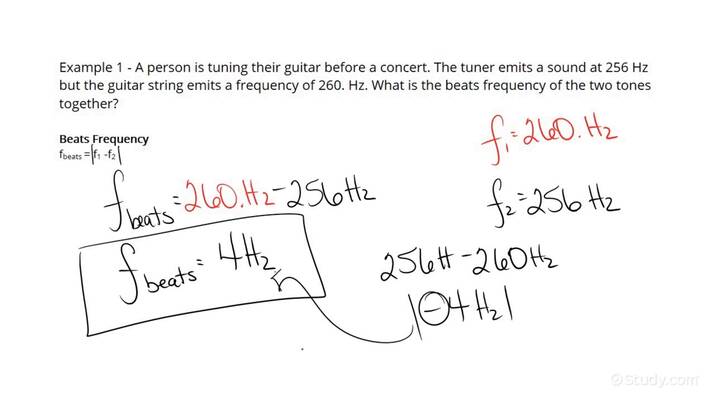Beat Frequency Calculator

Understanding Beat Frequencies: A Comprehensive Guide
Beat frequencies are a fascinating phenomenon that occurs when two sound waves of slightly different frequencies interfere with each other. This interference creates a periodic variation in sound intensity, known as beats. Whether you’re a musician tuning an instrument, an audio engineer working on sound design, or a physics enthusiast exploring wave interactions, understanding beat frequencies is crucial. Below, we delve into the science behind beat frequencies, how to calculate them, and their practical applications.
What Are Beat Frequencies?
Beat frequencies arise when two sound waves with frequencies close to each other are superimposed. The resulting waveform alternates between constructive and destructive interference, producing a pulsating sound. The beat frequency is the absolute difference between the two original frequencies.
For example, if one tuning fork vibrates at 440 Hz and another at 445 Hz, the beat frequency will be:
5 Hz (|445 Hz – 440 Hz|).
This means you’ll hear a pulsating sound with 5 cycles per second.
The Science Behind Beats
Beats are a direct consequence of wave interference. When two waves with nearly equal frequencies meet, their amplitudes add and subtract periodically. The mathematical representation of this phenomenon is:
[
y = A \cos(2\pi f_1 t) + A \cos(2\pi f_2 t)
]
Using the trigonometric identity for the sum of cosines, this simplifies to:
[
y = 2A \cos\left(2\pi \frac{f_1 - f_2}{2} t\right) \cos\left(2\pi \frac{f_1 + f_2}{2} t\right)
]
The term (\cos\left(2\pi \frac{f_1 - f_2}{2} t\right)) represents the beating envelope, with a frequency of (\frac{|f_1 - f_2|}{2}).
Practical Applications of Beat Frequencies
- Music and Tuning: Musicians use beats to tune instruments. For example, when tuning a guitar string, the beat frequency between the string and a reference tone decreases as the string approaches the correct pitch.
- Telecommunications: In radio communications, beat frequencies are used in heterodyne detection to shift signals to different frequency bands.
- Medical Diagnostics: In audiology, beat frequencies help assess hearing sensitivity by presenting two tones with slightly different frequencies.
How to Calculate Beat Frequencies
Calculating beat frequencies is straightforward. Follow these steps:
Formula:
[
\text{Beat Frequency} = |f_1 - f_2|
]
Beat Frequency Calculator: A Tool for Precision
To simplify calculations, a beat frequency calculator can be used. Here’s a basic HTML and JavaScript implementation:
<div class="calculator">
<label for="f1">Frequency 1 (Hz):</label>
<input type="number" id="f1" placeholder="Enter frequency 1">
<br>
<label for="f2">Frequency 2 (Hz):</label>
<input type="number" id="f2" placeholder="Enter frequency 2">
<br>
<button onclick="calculateBeat()">Calculate Beat Frequency</button>
<p id="result"></p>
</div>
<script>
function calculateBeat() {
const f1 = parseFloat(document.getElementById('f1').value);
const f2 = parseFloat(document.getElementById('f2').value);
const beatFrequency = Math.abs(f1 - f2);
document.getElementById('result').innerText = `Beat Frequency: ${beatFrequency} Hz`;
}
</script>
This tool allows users to input two frequencies and instantly get the beat frequency.
Comparative Analysis: Beats vs. Standing Waves
While both beats and standing waves involve wave interference, they differ significantly:
| Aspect | Beats | Standing Waves |
|---|---|---|
| Cause | Interference of two traveling waves | Superposition of incident and reflected waves |
| Frequency | Difference between two frequencies | Harmonics of the fundamental frequency |
| Application | Tuning instruments, telecommunications | Musical instruments, acoustics |

Historical Evolution of Beat Frequency Studies
The study of beats dates back to the 19th century. Physicist Georg Simon Ohm (yes, the same Ohm of Ohm’s Law) first described beats in 1843. His work laid the foundation for understanding wave interference and its applications in physics and music.
Future Trends: Beats in Modern Technology
As technology advances, beat frequencies are finding new applications:
1. Quantum Computing: Beats in electromagnetic waves are used to manipulate qubits.
2. Biomedical Imaging: Beat frequencies in ultrasound waves enhance imaging resolution.
3. Environmental Monitoring: Beat frequency analysis is used to detect subtle changes in natural soundscapes.
Myth vs. Reality: Common Misconceptions About Beats
- Myth: Beats only occur with sound waves.
Reality: Beats can occur with any type of wave, including light and electromagnetic waves.
- Myth: The beat frequency is always audible.
Reality: If the difference between frequencies is too large, beats may not be perceivable.
FAQ Section
Can beat frequencies occur with light waves?
+Yes, beat frequencies can occur with light waves, though they are typically observed in specialized experiments involving lasers or interferometry.
What is the maximum frequency difference for audible beats?
+For beats to be audible, the frequency difference should typically be less than 10 Hz, as the human ear can perceive beats up to this range.
How are beats used in telecommunications?
+In telecommunications, beats are used in heterodyne detection to shift signals to intermediate frequencies for easier processing and transmission.
Conclusion
Beat frequencies are a fundamental concept in physics with wide-ranging applications. From tuning musical instruments to advancing quantum computing, understanding beats is essential for anyone working with waves. By mastering the calculation and principles behind beat frequencies, you can unlock new possibilities in your field. Whether you’re a scientist, musician, or engineer, the humble beat frequency is a powerful tool in your arsenal.
"In the symphony of waves, beats are the silent conductors, orchestrating harmony and precision."
With this comprehensive guide, you’re now equipped to explore the world of beat frequencies with confidence and expertise.